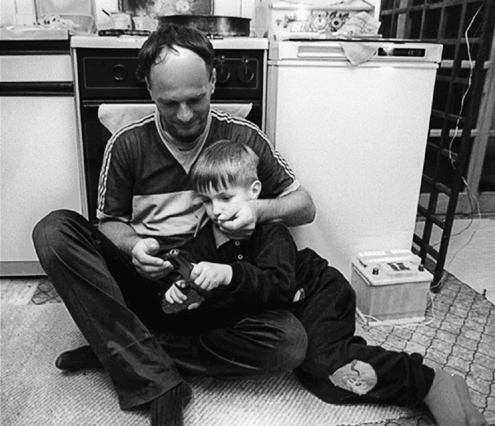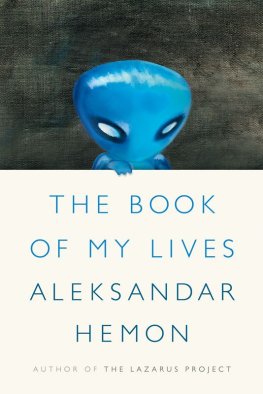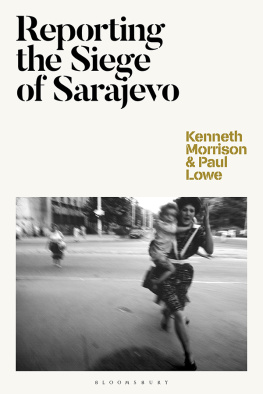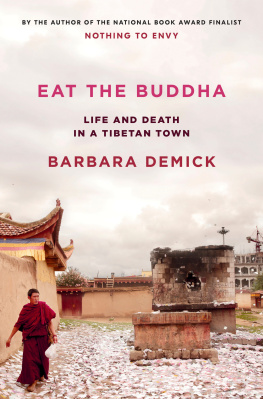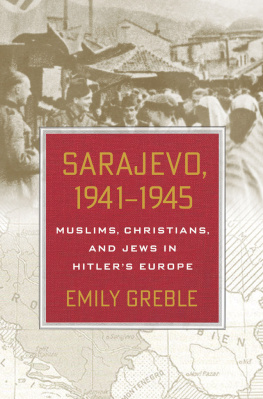ACKNOWLEDGMENTS
S O MANY RESIDENTS on Logavina Street gave generously of their time and insight, but none more so than Jela and Zijo Dino, who were my hosts on so many trips to Sarajevo. Members of the Kaljanac and Laevi familes also pitched in as guides and translators and friends.
This project was first conceived at The Philadelphia Inquirer and many fine editors worked with meFran Dauth, Max King, Don Kimelman, Robert Rosenthal, Nancy Szokan, Lois Wark, and David Zucchino, as well as foreign desk staffers Lisa Karoly and John Brumfield, and Inquirer writers Jane Von Bergen and Carrie Rickey.
In Sarajevo, Amela Filipovi first helped me pick Logavina Street. Among the journalists I worked with in Sarajevo in the 1990s who offered insight, outrage, companionship, rides in their bulletproof cars, were Joe Brand, Emma Daly, Tom Gjelten, John Pomfret, Kurt Schork, Samantha Power, David Rieff, Clay Scott, Ed Serotta, and Stacy Sullivan. Tracy Wilkinson of the Los Angeles Times has been involved with the project almost from its inception to the present.
Finally, this book is dedicated to my dear friend and fellow traveler Elizabeth Neuffer, the most committed journalist Ive known, who lost her own life covering the war in Iraq.
This book would not have been republished without my agent, Flip Brophy, and editors, Julie Grau in New York and Bella Lacey in London, as well as Laura Van der Veer. On my most recent trip to Sarajevo, Julie Talen shot video and acted as a sounding board; Zdravko Ljubas offered interpretation and analysis. Others who deserve thanks for bringing this book to fruition include Mark Bartolini, David Berreby, Ann Dalporto, Gladys Demick, Nicholas Demick, Gady Epstein, Molly Fowler, Terri Jentz, Nomi Morris, Evan Osnos, Catherine Peterson, Ben Rauch, Dave Schmerler, Isabel Schmerler, Margaret Scott, Laura Silber, and Dorothy Wickenden.
ALSO BY BARBARA DEMICK
NOTHING TO ENVY
SOURCES
Bass, Gary Jonathan. Stay the Hand of Vengeance: The Politics of War Crimes Tribunals. Princeton, NJ: Princeton University Press, 2000.
Gjelten, Tom. Sarajevo Daily: A City and Its Newspaper Under Siege. New York: HarperCollins, 1995.
Glenny, Misha. The Fall of Yugoslavia: The Third Balkan War. London: Penguin Books, 1992.
Kaplan, Robert D. Balkan Ghosts: A Journey Through History. New York: St. Martins Press, 1993.
Maas, Peter. Love Thy Neighbor: A Story of War. New York: Alfred A. Knopf, 1996.
Malcolm, Noel. Bosnia: A Short History. London: Macmillan, 1994.
Mousavizadeh, Nader, ed. The Black Book of Bosnia: The Consequences of Appeasement. New York: Basic Books, 1996.
Neuffer, Elizabeth. The Key to My Neighbors House: Seeking Justice in Bosnia and Rwanda. New York: Picador, 2001.
Power, Samantha. Breakdown in the Balkans: A Chronicle of Events, January, 1989 to May, 1993. New York: Carnegie Endowment for International Peace, 1993.
. A Problem from Hell: America and the Age of Genocide. New York: HarperPerennial, 2002.
Prstojevic, Miroslav. Sarajevo: Ranjeni Grad. Ljubljana: DAG Grafika, 1993.
Rieff, David. Slaughterhouse: Bosnia and the Failure of the West. New York: Simon & Schuster, 1995.
Rohde, David. Endgame: The Betrayal and Fall of Srebrenica, Europes Worst Massacre Since World War II. Boulder, CO: Westview Press, 1997.
Silber, Laura, and Allan Little. The Death of Yugoslavia. London: Penguin, 1995.
Stewart, Rory, and Gerald Knaus. Can Intervention Work? NewYork: W. W. Norton, 2011.
Thompson, Mark. A Paper House: The Ending of Yugoslavia. London: Vintage Books, 1992.
Toal, Gerard, and Carl T. Dahlman. Bosnia Remade: Ethnic Cleansing and Its Reversal. New York: Oxford University Press, 2011.
Vuillamy, Ed. Seasons in Hell: Understanding Bosnias War. London: Simon & Schuster, 1994.
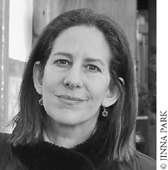
B ARBARA D EMICK is the Beijing bureau chief of the Los Angeles Times. Her coverage of Sarajevo for The Philadelphia Inquirer was a finalist for the Pulitzer Prize in international reporting and won the George Polk Award and the Robert F. Kennedy Award. Her reporting on North Korea won the Overseas Press Clubs award for human rights reporting as well as awards from the Asia Society and the American Academy of Diplomacy. She is the author of Nothing to Envy: Ordinary Lives in North Korea, a finalist for the National Book Award and the National Book Critics Circle Award, and winner of the Samuel Johnson Prize.
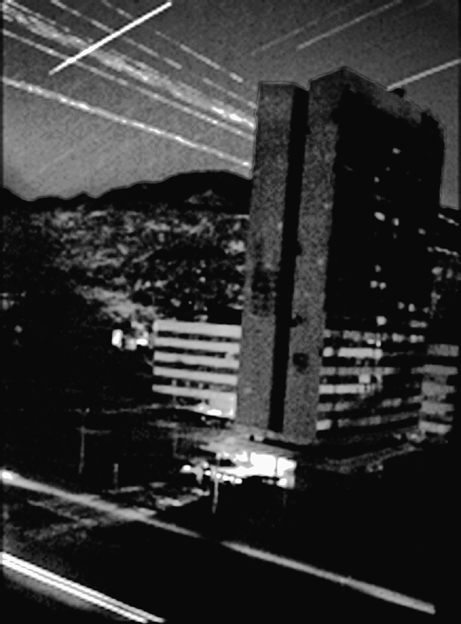
February 1994In this time-lapse photo, stars streak to the right and tracer bullets fired from the Serb-held hillside streak to the left across downtown Sarajevo behind the Bosnian parliament building. The view is from the Holiday Inn, from which Bosnian Serbs fired on pro-unity demonstrators at the beginning of the war.
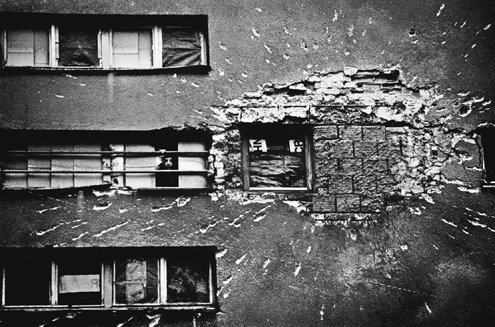
Shrapnel scars virtually every building, street, and sidewalk in Sarajevo.
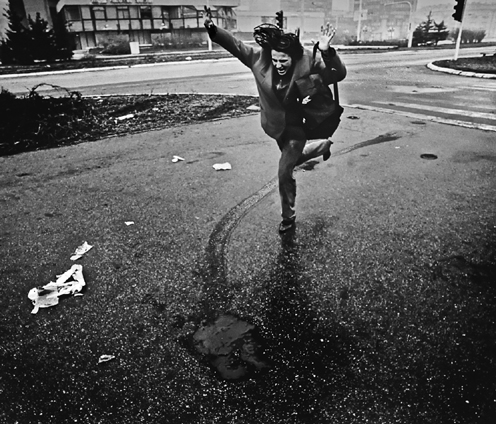
A woman sprints toward safetytrying to avoid the bloody path left by a sniper victim, whose body had been dragged away moments before.
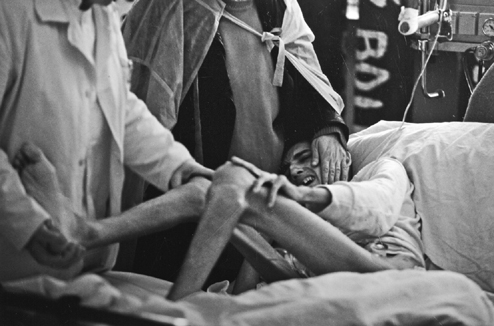
Amir Goro was one of four students from the Razija Omanovi school who were machine-gunned in the street. He lost half his body weight in the State Hospital of Sarajevo, which was without heat, medicine, or basic equipment and where families had to bring food for patients.
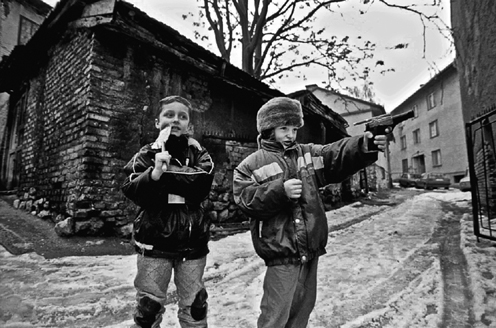
Boys at play set up a make-believe checkpoint on Logavina Street.
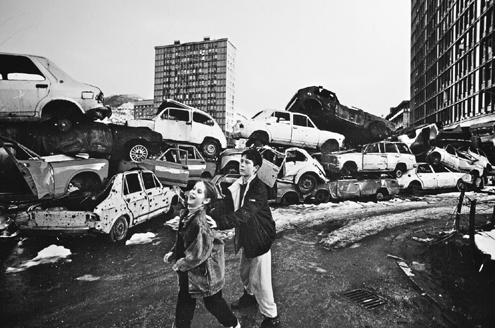
Children play behind a barricade of cars shredded by artillery and bullets. The barricades limit the line of sight for snipers a couple hundred yards away.
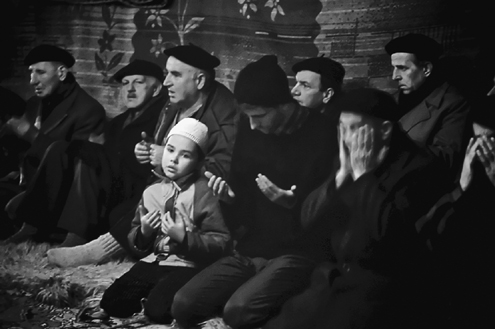
Muslim men and boys pray at a six-hundred-year-old mosque. The prayer service took place only days after a Serb shell killed sixty-eight people, including a woman from this congregation.

Haris Kaljanac, nine, is stuck inside along with his cat during one of the most dangerous times in the war.
